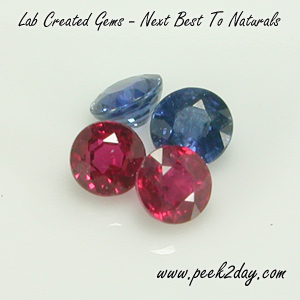SYNTHETIC GEMS
LAB CREATED SYNTHETIC GEMS ARE IDEALLY SUITED FOR WHOLESALE GEMSTONE JEWELRY
 Before we go on to discuss how lab created gems are a major driving force in wholesale jewelry, we need to understand what exactly is meant by synthetic or lab created gems. We all know what natural gems are, they are stoned formed in nature and extracted by man. Beyond the definition of natural gems, things get to be a bit confusing. You might hear of imitation gemstones, fake gems, flame fusion gems, synthetic gems, lab created gems, created gems etc. We can club all this trade jargon under one title, 'Not Natural Gems'. But for the serious gemstone enthusiast, we need to classify these gems into two main types. In our report, we will use the term imitation gems to include, all man made gems that try to imitate natural gems merely on the basis of color. The material used to make imitation gems has no relation to the chemical formula, of the natural gem that they hope to 'imitate'. So an imitation ruby could be made from colored glass, resin, plastic, acrylic or any other material. As you might have guessed, imitation gems are inexpensive, they do enjoy significant popularity in the wholesale jewelry segment. Brass and even silver jewelry is often made with cheap imitation gems. These stones are ideal in markets where, buyers look for inexpensive flashy jewelry. You could have a 10 carat imitation ruby in a brass ring plated with white gold. The gem would be absolutely transparent, with no color zoning and without any inclusions - after all it was bulk produced in a factory.
Before we go on to discuss how lab created gems are a major driving force in wholesale jewelry, we need to understand what exactly is meant by synthetic or lab created gems. We all know what natural gems are, they are stoned formed in nature and extracted by man. Beyond the definition of natural gems, things get to be a bit confusing. You might hear of imitation gemstones, fake gems, flame fusion gems, synthetic gems, lab created gems, created gems etc. We can club all this trade jargon under one title, 'Not Natural Gems'. But for the serious gemstone enthusiast, we need to classify these gems into two main types. In our report, we will use the term imitation gems to include, all man made gems that try to imitate natural gems merely on the basis of color. The material used to make imitation gems has no relation to the chemical formula, of the natural gem that they hope to 'imitate'. So an imitation ruby could be made from colored glass, resin, plastic, acrylic or any other material. As you might have guessed, imitation gems are inexpensive, they do enjoy significant popularity in the wholesale jewelry segment. Brass and even silver jewelry is often made with cheap imitation gems. These stones are ideal in markets where, buyers look for inexpensive flashy jewelry. You could have a 10 carat imitation ruby in a brass ring plated with white gold. The gem would be absolutely transparent, with no color zoning and without any inclusions - after all it was bulk produced in a factory.
You should not refer to imitation gems as synthetic or lab created gems unless, you wish to add to the existing confusion in the industry. The names lab created, created and synthetic refer to the same type of man made gems and they are, totally different from imitation gems that we just talked about. A lab created emerald for example, would do much more than try to merely imitate the color of natural emeralds. Synthetic or lab created gems, clone the physical, chemical and optical properties of the natural gem that they claim to represent. A good example is alexandrite, the exotic gem that actually changes color when the light source changes. Lab created alexandrite will clone the natural stone in every respect and will therefore, show the color change effect too. Wholesale jewelry can benefit a lot from lab created gems as these stones, are 'almost' natural, they can be produced in similar color and clarity too. The uniformity of synthetic gems makes them very suitable for wholesale gemstone jewelry. These gems are obviously more expensive as compared to inexpensive imitations. However it is important that like imitation gems, lab created gems also be clearly explained and declared to the buyer.
So when you think of making wholesale jewelry and find that the price of natural gemstones a bit too high for your price point, consider the other options available to you. Just to repeat what we said above, do make sure that your customers are informed about the type of gems that you use.

